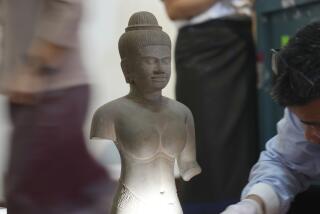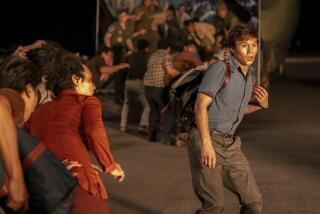Spoils of War Are Peacetime Draw
CU CHI, Vietnam â In the jungles of Tay Ninh province, rifle fire echoes through bamboo groves and Le Van Tung raises the leaf-covered lid over an underground tunnel, peering cautiously about before striding to his briefing room.
Time is frozen. Women in black pajamas walk the paths, and men in brown guerrilla uniforms and sandals snooze in hammocks. A disabled U.S. Huey chopper, riddled with bullet holes, sits abandoned in a clearing. Nearby, Le, 45, a former Viet Cong guerrilla, taps his pointer on a huge map for attention and launches into a briefing on the military situation--as it was on this day 30 years ago.
âThe American 25th Infantry Division is here,â he says in English, pointing to a spot on the map two or three miles from where he is standing. âTwenty thousand Americans. They attacked every day. They knew the tunnels were here, that we lived in them, but they could never find us.â
War, of course, has not returned to Cu Chi, a two-hour drive northwest of Ho Chi Minh City, formerly Saigon. The dozen visitors Le briefed on the military situation were Korean, French and American tourists, and the sounds of rifle shots came from a firing range where foreigners can shoot a U.S. M-16 or a Soviet-made AK-47 for $2.
But even in peacetime, war can be big business. Cu Chiâs 150-mile network of tunnels, dug between 1960 and 1973 and built three layers deep, have become Vietnamâs most popular tourist attraction since they were opened nine years ago--and widened so Westerners could squeeze through the dark maze of narrow passageways leading to underground medical clinics, command posts, living quarters and meeting rooms.
The tunnels are part of a vast war-related cottage industry springing up throughout Vietnam.
A war museum, commemorating the U.S. Christmas bombing of Hanoi in 1972, opened in the capital in January. Street vendors do a brisk business selling toy jeeps and helicopters fashioned out of discarded Coke cans and hawking (fake) dog tags and (counterfeit) Zippo lighters engraved with GI slogans like âDeath is my business and business has been good.â
Some Westerners wonder what message Vietnam is sending by opening the $1.4-million war museum in Hanoi and the prison that American POWs called the Hanoi Hilton just as relations with Washington are moving toward normalization. Other than wanting to generate tourist revenue, the answer is that there is no message, for the United States at least.
âWe do not do this to humiliate the Americans,â said Nguyen Thi Thao, curator of the museum and memorial in My Lai, where U.S. soldiers massacred nearly 500 villagers in 1968. âWe do it so that the Vietnamese will not forget, so our schoolchildren can understand the suffering of their elders and learn from history.â
In general, Vietnam, which lost 3 million people from 1965 to 1975, has been more successful than the U.S. in letting its scars of war heal and has been more forgiving.
Forgiving, however, does not mean forgetting. Hanoi painter Le Thanh, 55, has never removed the B-52 engine that fell into his garden in 1972--âHow can a nation forget its suffering?â he asks--and schoolchildren by the busloads make pilgrimages to Vietnamâs war museums.
What the museums offer is selective history: Pictures--many of which first appeared in Life and other U.S. magazines--of American POWs playing volleyball; GIs grinning over the corpses of Viet Cong guerrillas; napalm turning villages into crematories. They all reinforce Vietnamâs self-image as the underdog triumphing over great odds.
More to Read
Sign up for The Wild
Weâll help you find the best places to hike, bike and run, as well as the perfect silent spots for meditation and yoga.
You may occasionally receive promotional content from the Los Angeles Times.






